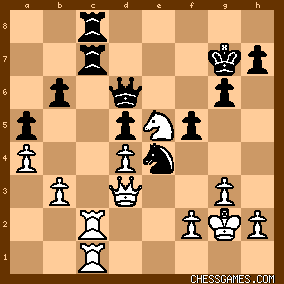| Jul-29-06 | | Maynard5: The position looks essentially level -- and surprisingly symmetrical -- around move 30. Then, Black's ill-advised attempt to break on the kingside with 31. ... f4? gives White the opportunity to penetrate, via Qg4 and Qe6. In the ensuing endgame, White's knight is more mobile, ensuring the gain of a pawn, although the win does require some technique. |
|
| Sep-21-06 | | Resignation Trap: March 30-31, 1951
Botvinnik's journal entries were getting shorter:
"Must, at last, play a decent game. Time! But in general don't hurry (25-30 moves!). Let's go!"
|
|
| Sep-21-06 | | Resignation Trap: After his second consecutive win, Botvinnik still wasn't satisfied with his play! This is what he had to say: "Played, in general, passively, and also blundered (Rxc2?). For the moment rather weak. And analyzed disjointedly. Don't listen to the seconds during analysis." Both players overlooked 32...Rxc2 33.Rxc2 Nh5! and Botvinnik was disgruntled about permitting this possibility. |
|
| Dec-09-06 | | suenteus po 147: <Don't listen to the seconds during analysis.> LOL. Didn't Fischer adopt this very strategy in '72? Anyway, I'm curious to know who Botvinnik's seconds were during this championship. |
|
| Mar-23-08 | | Knight13: 66. Kf5 Nxd5 1-0.
|
|
| Apr-29-13 | | marljivi: Flohr and Ragozin were Botvinnik's seconds during this match. |
|
Sep-13-13
 | | plang: 7 b3 with the idea of exchanging dark-squared bishops is a system attributed to Botvinnik. Botvinnik after 13 e3:
"Had the black pawn been at f7, the game would have been completely equal. Now, however, despite the following simplification, White retains a slight positional advantage, for the reason that this pawn is at f5 - the weakness of the e5 square may tell." Bronstein after 30..Nf6:
" During the game I was not so confident about the harmlessness of the ending after the simple 31 Rxc7+..Rxc7 32 Rxc7+..Qxc7 33 Qa6..Qb8. Now I see (as Botvinnik saw then) that White has no realistic way of breaking through. But at the time my character did not allow me to await the future passively, and as a result - my "plat du jour"." In mutual time trouble both players missed, after 32 gxf?!, the response 32..Rxc2 33 Rxc2..Nh5 34 Nd3..Rxc2 35 Qxc2..Nxf4+ 36 Nxf4..Qxf4 with an even ending. Bronstein, in his calculations, had overlooked 35 Qg4 leading to a winning knight ending. After the alternative 40..Nc1 41 Nxd5..Nxb3 42 Ke3 the Black knight would have been trapped. Botvinnik after 43 Ne5:
"White's plan is straightforward: post his knight at d3, and then begin making use of his extra pawn on the queenside. It is important, only, that in so doing he should not allow the enemy king to approach his f and h pawns." The alternative 53 Nc5+..Nxc5 54 dxc..Kd7 55 Kd3..Kc6 56 Kd4..h4! would have given Black too much play. |
|
| Sep-13-13 | | parisattack: Beautiful game by Botvinnik.
The Modern Stonewall (...Bd6) of course allows Black to play ...Qe7 preventing (at least for awhile) the Ba3 Bishop sortie by White. |
|
| Sep-13-13 | | Ulhumbrus: An alternative to 12...Nxd7 supporting the advance ...c5 12...Qd7 supporting the advance ...b5 Instead of the withdrawal 21...Nf6, 21..Qe6 begins the plan of ...Nd6 followed by ...c5-c4 |
|
May-14-18
 | | offramp: At move 30 the position is almost symmetrical.

click for larger view
The difference is the f-pawns. White's KBP has not moved, but Black's has advanced to f5. That seemed to be enough for Botvinnik to eke out a win. |
|
| Mar-20-21 | | tbontb: As noted above, the game remains objectively equal even after 31....f4 but Bronstein misses the obvious (and strong) 35. Qg4 Nf6 36. Qe6 threatening f5 to capitalise on the material. The ending after exchange of Qs is a text book loss as White easily uses his extra decoy pawn to tie down the Black N before forcing the win on the K-side ("Knight endings are really pawn endings"--Botvinnik). |
|
| Apr-04-21 | | Ulhumbrus: After 17...exd5 Botvinnik refrains from the capture dxc5 giving his opponent the so called "hanging pawns" and waits instead for Bronstein to play the capture 28...cxd4 which gives White the superior pawn structure. |
|
| Jul-06-22 | | cehertan: Resignation trap made the most salient comment, 32..Rxc2 33.Rc2 Nh5 gives black the better side of a dead draw. In 2 straight games a simple little oversight cost him the match. Unless the Soviet fix was in as Bronstein and many others have implied, I guess you would have to credit WC jitters. I will always believe that Bronstein was the stronger player during his prime. A great guy too as I learned once at Hastings, very amiable and down to earth. |
|
| Jul-08-22 | | Cassandro: 31...f4 is a strategic mistake. |
|
| Jul-08-22 | | Olavi: Bronstein used to repeat that he won all his games before adjournment, while Botvinnik after. Well, here the game is decided on move 32... |
|
| Jul-08-22 | | Olavi: But of course that is complete nonsense, as is most that Bronstein said about Botvinnik. |
|





